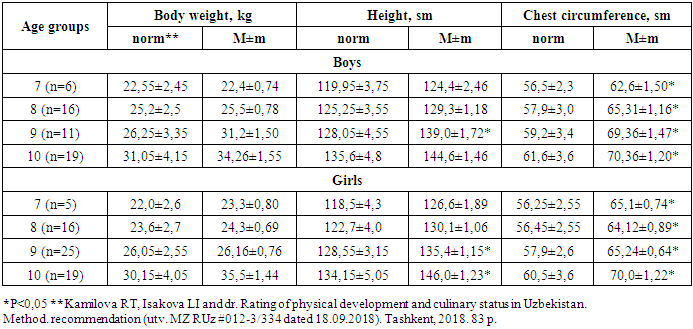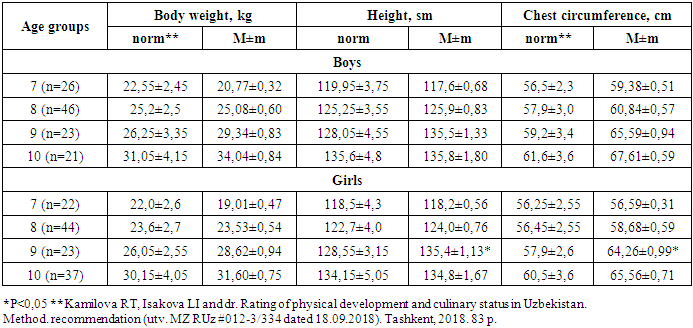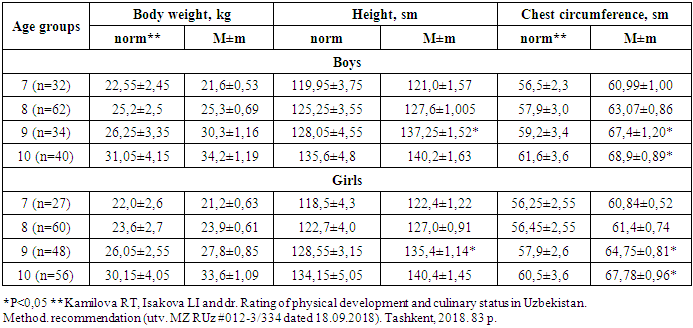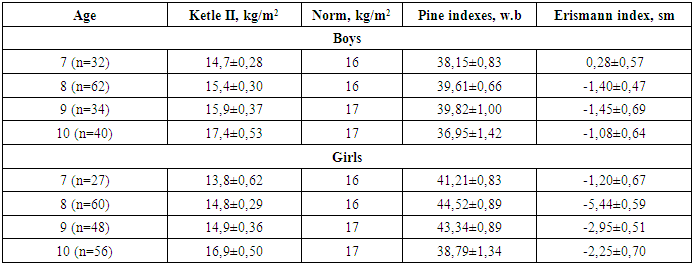-
Paper Information
- Paper Submission
-
Journal Information
- About This Journal
- Editorial Board
- Current Issue
- Archive
- Author Guidelines
- Contact Us
International Journal of Genetic Engineering
p-ISSN: 2167-7239 e-ISSN: 2167-7220
2024; 12(6): 111-115
doi:10.5923/j.ijge.20241206.08
Received: Oct. 28, 2024; Accepted: Nov. 22, 2024; Published: Nov. 28, 2024

Physical Development of Primary Class Students in Rural Conditions of Kashkadarya Region
H. Hazratova1, Y. Rakhmatullaev2
1Samarkand State University named after Sharof Rashidov, University Avenue 15, Samarkand, Uzbekistan
2Karshi State University, 17, Kuchabog Street, Karshi, Uzbekistan
Copyright © 2024 The Author(s). Published by Scientific & Academic Publishing.
This work is licensed under the Creative Commons Attribution International License (CC BY).
http://creativecommons.org/licenses/by/4.0/

This article sdudies body weight, height, chest circumference and some anthropometric indices of 359 7-10 year old schoolchildren studying in rural conditions of Kashkadarya region. According to the obtained results, somatometric indicators of students do not significantly differ from existing standards. Their anthropometric indices were found to belong to the weak and very weak type in children of both sexes. In order to prevent such a situation, it was discussed the need to rationalize the students' daily diet and develop appropriate practical measures in this regard.
Keywords: Physical development, Body weight, Height, Chest circumference, Anthropometry, Harmonic development
Cite this paper: H. Hazratova, Y. Rakhmatullaev, Physical Development of Primary Class Students in Rural Conditions of Kashkadarya Region, International Journal of Genetic Engineering, Vol. 12 No. 6, 2024, pp. 111-115. doi: 10.5923/j.ijge.20241206.08.
1. Introduction
- Currently, the study of indicators of physical development of schoolchildren, in particular body weight index, is being conducted in different directions abroad and in our Republic [1-8,11-17]. According to the conclusions of researchers and scientists working in this field, the study of physical development of children and adolescents has entered a new stage [9-14]. In general, this issue is extremely complex, and the factors that affect children's body weight, height, chest circumference and other indicators are increasing and changing year by year [15-20]. Therefore, it will be useful to study the growth and development of schoolchildren, especially in rural conditions, to determine body weight, height, Ketle's index, chest circumference and other indicators of biological development and compare them with average values [17-21].The study of the morphofunctional indicators of modern schoolchildren serves first of all for their health and the satisfactory performance of their mental and physical activities. This issue is one of the urgent tasks in our country and worldwide. Non-infectious and malnutrition-related diseases that occur especially among children and adolescents, their prevention, growth disorders in children, etc. are considered to be one of the important scientific and theoretical issues of physiology and medicine. In particular, body weight, height, chest circumference are among the main indicators that determine children's normal physical development and socio-economic status [5,10,20]. During the research conducted in our republic and abroad, special attention is paid to the above-mentioned issues, and the influence of various factors on the growth and development processes of children is being studied. Body weight, height, chest circumference and other somatometric indicators of elementary school students are affected by the environment they live in, daily diet, mental and physical loads, and the way they organize their daily routine. In this regard, the study and analysis of morphofunctional indicators of children of junior school age is considered one of the urgent tasks.
2. Materials and Methods
- Observations were conducted among 359 students aged 7-10 (including 7-year-olds - 59, 8-year-olds - 122, 9-year-olds - 82, 10-year-olds - 96) studying in rural schools of Kasbi district of Kashkadarya region in 2021-2022. Physical development indicators of students were checked anthropometrically.
3. Results
- During the observations, the body weight, height and chest circumference of the 7-10-year-old students were determined. According to the obtained results, the anthropometric indicators of students do not significantly differ from the existing standards. As students get older, their body weight, height, and chest circumference increase. In the table below, we present the results obtained in 2021.
|
|
|
|
4. Discussion
- Assessment of children's physical development is based on statistical analysis methods. The results of the somatometric parameters are compared with the data in the available tables and the mean values (M), mean square deviation (SD) and others are analyzed. The information obtained is used to create a physical development profile. Depending on the degree of deviation, average, above average, average and low physical development are studied.Physical development indicators of students differ from existing standards. This situation calls for the rationalization of the daily diet of elementary school students and the development of appropriate practical measures in this regard. At the same time, it requires that parents, school management and teachers perform their duties responsibly.
5. Conclusions
- Based on the results of the study of some anthropometric indicators of 7-10-year-old students in rural schools of Kashkadarya region, it can be concluded as follows:1. Some anthropometric indicators of students increase depending on their age;2. 9-10-year-old pupils' body weight, height and chest circumference are higher than 7-8-year-old pupils and the norm;3. There was no significant difference between the results of Ketle's index, Pine's index and Erisman's index in boys and girls;4. Weak and very weak body types were observed in children of both sexes;5. Underweight was more common in girls than in boys;6. There was no obesity among the schoolchildren who were observed.
 Abstract
Abstract Reference
Reference Full-Text PDF
Full-Text PDF Full-text HTML
Full-text HTML


